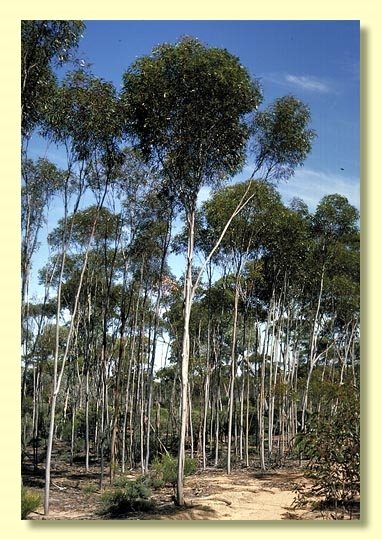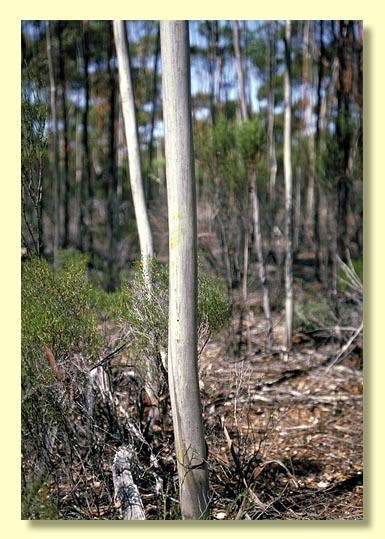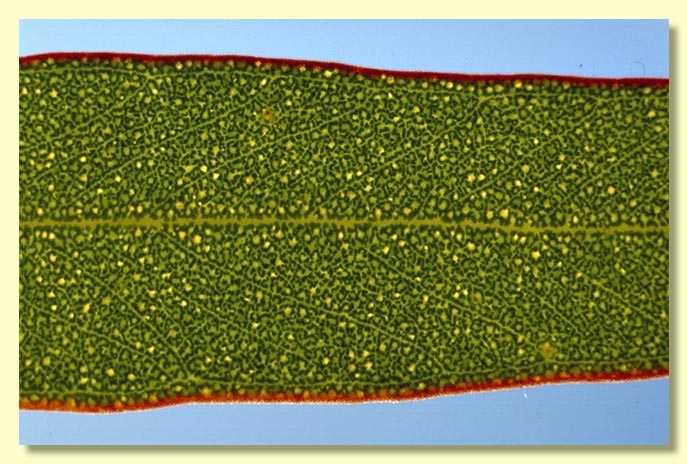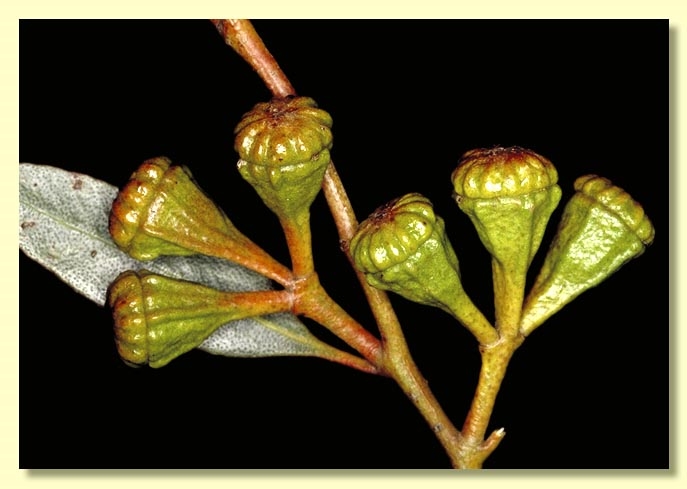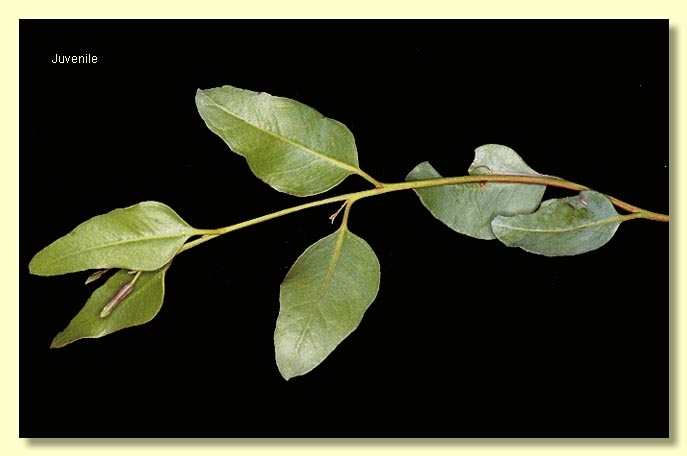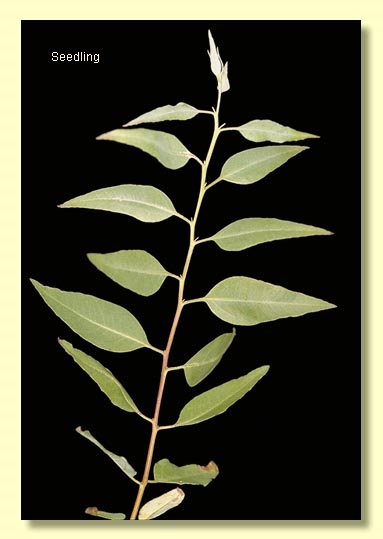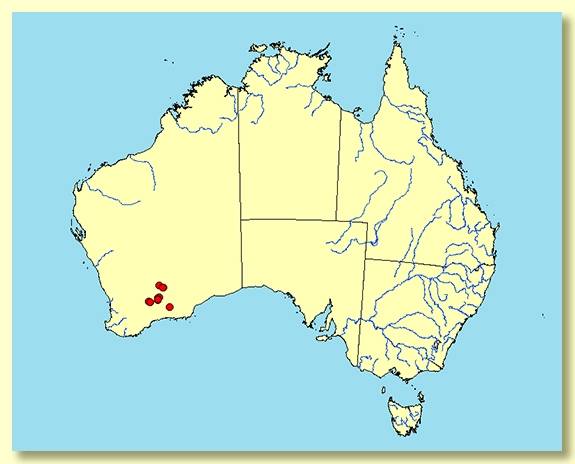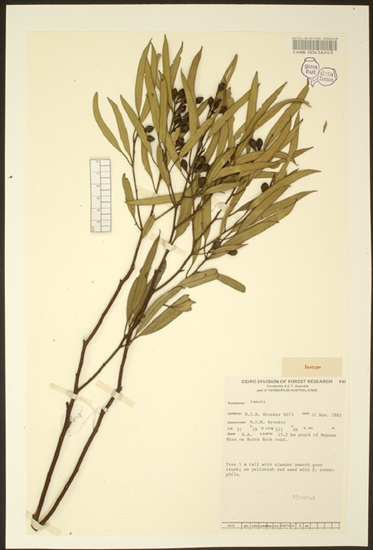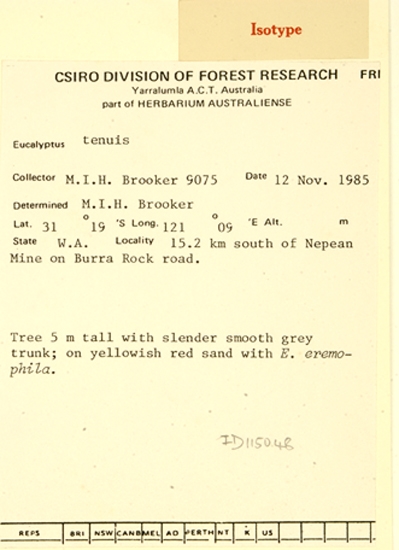Eucalyptus | Symphyomyrtus | Dumaria | Rufispermae
Euclid - Online edition
Eucalyptus tenuis
Slender mallet to 10 m tall. Lacking a lignotuber.
Bark smooth throughout, rarely powdery, pale grey to whitish over orange to pale brown, shedding in long ribbons.
Branchlets have oil glands in the pith.
Juvenile growth (coppice or field seedlings): stems rounded in cross-section; juvenile leaves always petiolate, opposite at lowest node only then becoming alternate, lanceolate, 5.5–8 cm long, ca 1.3–3.5 cm wide, lowest leaves dull, bluish but soon glossy, green.
Adult leaves alternate, petioles 1–2 cm long; blade lanceolate, 6.2–11 cm long, (0.6)0.7 –1.5 cm wide, base tapering to petiole, margin entire, apex pointed, concolorous, very glossy, green, side-veins at an acute or wider angle to midrib or sometimes obscure, reticulation dense to very dense, intramarginal vein close to margin, oil glands numerous, intersectional.
Inflorescence axillary unbranched, peduncles 0.4–2(3.1) cm long, buds 3 per umbel, pedicellate, pedicels (0.3)0.5–0.8(1.1) cm long. Mature buds pyriform to obovoid (0.8–1 cm long, 0.6–0.9 cm wide) with up to 12 distinct radial ribs on operculum, less prominently ribbed on hypanthium, scar present (outer operculum shed early in development), inner operculum rounded to somewhat flattened (0.35–0.5 cm long), stamens regularly inflexed, all fertile, cuboid to wedge shaped versatile anthers, dorsifixed, dehiscing by longitudinal slits, style long and straight, stigma blunt, locules 4(5), the placentae each with 4 vertical rows of ovules. Flowers creamy white.
Fruit pedicellate, pedicels (0.2)0.3–0.7(1.1) cm long, usually obconical or cupular-obconical, sometimes campanulate, 0.8–1.2 cm long, 0.8–1 cm wide, shallowly to distinctly but sparingly ribbed, disc descending obliquely, valves 4(5), near rim level.
Seeds reddish to brown and glossy, 1.2–3 mm long, flattened -ovoid and often angular in outline, sometimes lacunose, dorsal surface scarcely reticulate, hilum ventral.
Cultivated seedlings (measured at ca node 10): cotyledons reniform; stems square in cross-section, scarcely glaucous or non-glaucous; leaves always petiolate, opposite for 3 to 5 nodes then alternate, lanceolate, 6.5–8.5 cm long, 2–3 cm wide, green, becoming glossy, but maybe with slight waxiness when young.
Flowering has been recorded in March.
An erect slender mallet (non-lignotuberous tree), endemic to the goldfields area of Western Australia, occurring in the "Hyden scrub" well east of Hyden towards Norseman, predominantly in the Burra Rock to Mount Day and Maggie Mays Hill area. The trunks are smooth with recently shed bark often hanging in ribbons. The adult leaves are glossy, bright green, buds and fruits occur in cluster of 3 and are shallowly but distinctly ribbed, and opercula rounded to flattened; fruit are more or less obconical.
In the classification of Brooker (2000) Eucalyptus tenuis belongs in Eucalyptus subgenus Symphyomyrtus section Dumaria having these features: buds initially with two opercula the outer shed early, stamens strongly inflexed, ovules in 4 rows on the placentae and cotyledons reniform. Within section Dumaria the species belongs to a large sub-group of closely related species (series Rufispermae, 37 described species and subspecies) diagnosed by glandular pith in the branchlets, cuboid to wedge shaped versatile anthers, and by the reddish brown and glossy, flattish seeds which are unique to the series.
Within series Rufispermae the slender-stemmed mallet E. tenuis is distinctive in having only three-flowered inflorescences. Only one other mallet species from series Rufispermae has buds in clusters of 3, E. frenchiana, which has fruit 1-1.3 cm wide (0.8–1 cm wide in E. tenuis ) and which are much more prominently ribbed. The other series Rufispermae mallet species in this area have buds in 7s with maybe an odd cluster of 3. The buds and fruit of E. tenuis are smaller and less prominently ribbed than those in the (3)7-budded E. pterocarpa the fruit of which are 1.4–2.3 cm wide. Another related mallet species from the same area is the recently described E. distuberosa (with two subspecies) which has smaller buds mainly in clusters of 7 or (3)7 and more cupular fruit (fruit 0.6–0.8 cm wide) compared with E. tenuis but is otherwise similar.
The smooth-barked E. tenuis also has fruit more shallowly ribbed than two other goldfields mallets, E. lesouefii and E. corrugata, both of which are black-butted trees. In addition the fruits of E. lesouefii are usually glaucous whilst the more distantly related three-budded E. corrugata also differs in having black pitted seed (not ruby-red lustrous).
In earlier editions of EUCLID Eucalyptus tenuis was regarded as a mallee (lignotuberous plant) or a mallet but this was an error.

